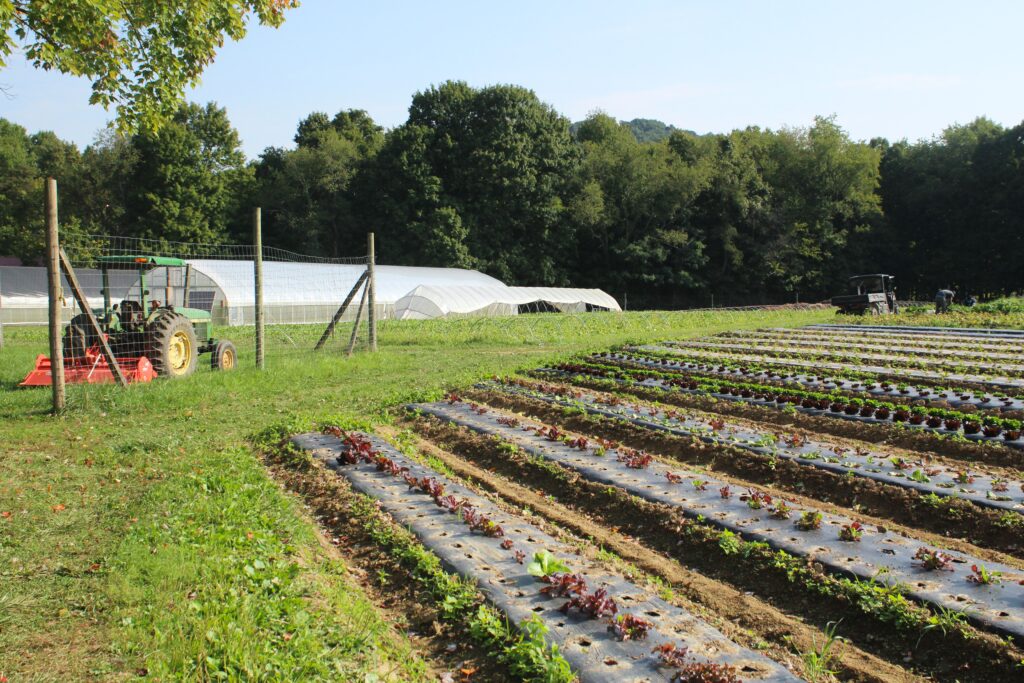Mary Oldman and Francisco Ramirez own and operate Mountain Harvest Farm just south of Morgantown.
Standing in front of a high tunnel full of kale and cherry tomatoes, Oldman said that key pieces of the farm have been made possible through Natural Resources Conservation Service (NRCS) programs and funding. The NRCS is an agency of the United States Department of Agriculture (USDA) that provides technical assistance to farmers and other private landowners and managers.
“This was an EQIP contract from the NRCS for this high tunnel and the micro irrigation inside,” she said. “That particular contract also helped us put in a main irrigation line from the road.”
Oldman said she believes the previous owner also used EQIP funds (Environmental Quality Incentives Program) from the NRCS to create a pond, install irrigation across the entire property and install French drains under some of the fields.
“That’s the main NRCS program we’ve been involved in and has really helped us a lot,” she said. “These high tunnels have been really crucial to our operation, you know, growing year round, but also becoming more profitable.”
The farm hosted Terry Crosby, chief of the NRCS, Tuesday morning to get a better understanding of the unique challenges facing Appalachian farmers. One issue he heard quite a lot about was deer pressure.
“I wouldn’t have a farm here without a fence in this area,” Ramirez said. “The first year we started, I worked so hard the whole summer. I remember it was October. We just needed a couple weeks, and the deer ate everything.”
Crosby said the NRCS doesn’t offer assistance for fence installation, but the trip is already making him consider policy changes.
“How do we make them more flexible so we can offer something, because for a vegetable person to be successful, you got to take the pressure off,” he said. “Especially if you’re going the organic route, you can’t have any pressure from pests.”
Crosby said many of the programs that Mountain Harvest Farm benefits from have existed for decades, but close to $20 billion in conservation funding from the Inflation Reduction Act is allowing for significant expansions. Most notably, the USDA is increasing the minimum annual payment for new and renewed Conservation Stewardship Program contracts aimed at improving the condition of land from $1,500 to $4,000 starting in fiscal year 2024.
“This is my 46th year at USDA, and we’ve never had an opportunity like this,” he said. “We have a lot of producers walking through the door. We meet them where they are on the land, and so what it has given us is an opportunity to serve more folks, and our agency is a service organization.”
Crosby said the impacts of the COVID-19 pandemic and subsequent supply chain issues highlighted to him the importance of local food production, particularly in and near urban centers.
“In that 2021 era, folks just couldn’t find that fresh food and vegetable anywhere,” he said. “If you’re able to grow it on the farm, you’re able to walk out your back door, if you’re able to put it on your salad at night. Just think about what they would do to the health costs if we had everyone that would be able to have access to food like this.”
Agriculture isn’t necessarily what comes to mind when most people think of West Virginia. That never made sense to Jon Bourdon, state conservationist for the NRCS in West Virginia.
“West Virginia is diverse in all sorts of ways, but if you look at the state emblem, it’s a coal miner and a farmer,” Bourdon said. “I call it community scale agriculture, or West Virginia traditional agriculture, that traditional Appalachian farming that I think has some in some ways, has fallen asleep for a while as people went big. There is a coming back.”
Despite its location several miles outside of Morgantown, Mountain Harvest qualifies for NRCS urban farm programs. Bourdon said he believes mountain farming shares many challenges with urban farming.
“The same challenges that they have of getting assistance and that infrastructure and how to use that land is very similar to if you have mountains on both sides,” he said. “You’re in similar food deserts. It is urban as it falls under our policy, but we call it more community scale or small scale agriculture.”
With housing developments cropping up in the area, the urban label may make more sense in the coming years.























